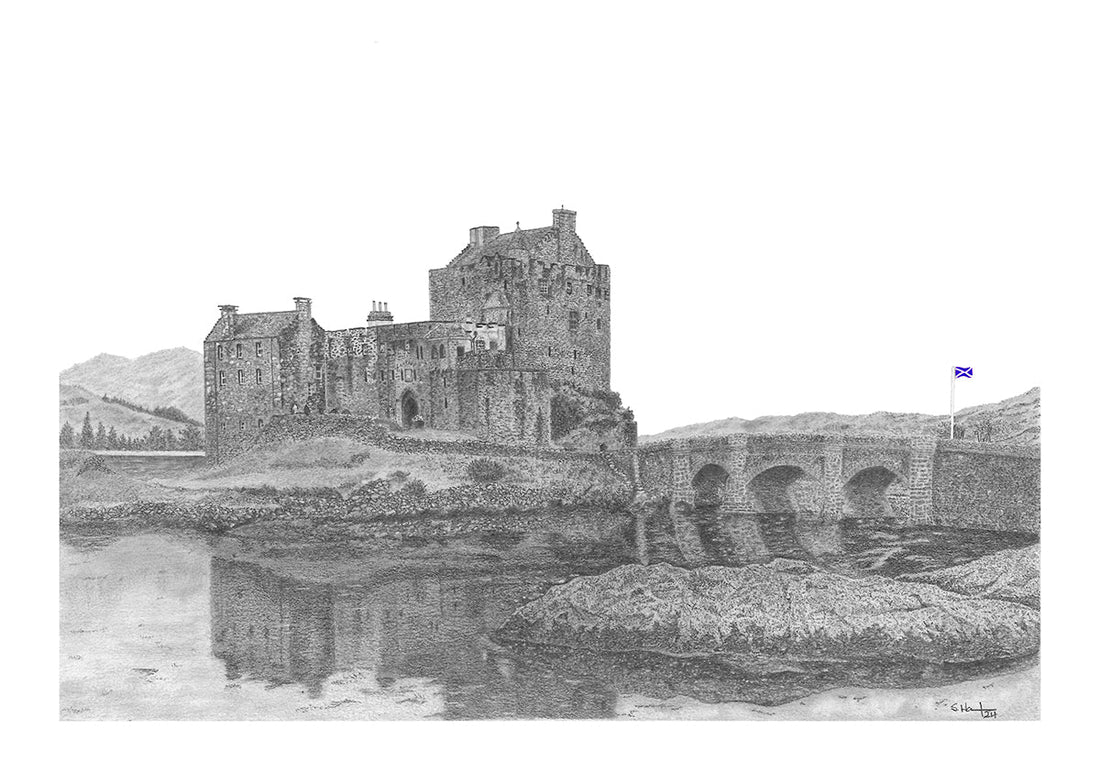
Awe of the Highlands - Eilean Donan Castle
Share
Exploring the Majestic History of Eilean Donan Castle
On a small tidal island where three sea lochs meet—Loch Duich, Loch Long, and Loch Alsh—Eilean Donan Castle stands as one of Scotland's most iconic landmarks. Its picturesque setting, coupled with a storied past, draws visitors from around the globe. Join us as we journey through the fascinating history of Eilean Donan Castle, a symbol of Scottish heritage and resilience.
Early Beginnings and Construction
The history of Eilean Donan Castle dates back to the early 13th century. The exact date of its construction is not documented, but it is believed that the original castle was built around 1220 by Alexander II to defend the region from Viking incursions. The name "Eilean Donan" translates to "Island of Donan," named after the 6th-century Irish saint, Bishop Donan, who is thought to have established a church on the island.
Clan Mackenzie and Clan Macrae
The castle’s ownership and importance grew over the centuries, especially under the influence of Clan Mackenzie. In the late 13th century, Eilean Donan became a stronghold of the Mackenzie Clan, an influential family in the Scottish Highlands. The castle also served as a refuge for Robert the Bruce during the Wars of Scottish Independence.
By the 14th century, the Macraes, loyal supporters of the Mackenzies, played a significant role in the castle’s history. Known as the "Mackenzies' Coat of Mail," the Macraes were instrumental in defending Eilean Donan. Their loyalty was pivotal during the turbulent times that followed.
The Jacobite Risings and Destruction
Eilean Donan's strategic location made it a focal point during the Jacobite risings in the 17th and 18th centuries. In 1719, during the first Jacobite uprising, the castle was garrisoned by Spanish troops supporting the Jacobite cause. However, their efforts were thwarted when the British government dispatched warships to dismantle the rebellion. On May 10, 1719, the castle was bombarded and subsequently destroyed by naval forces, leaving it in ruins for nearly 200 years.
Restoration and Modern Era
The castle lay abandoned and in disrepair until the early 20th century when Lieutenant Colonel John Macrae-Gilstrap embarked on a project to restore it. His vision and dedication, coupled with the architectural expertise of Farquhar Macrae, breathed new life into Eilean Donan. The restoration, which began in 1911, meticulously rebuilt the castle based on historical records and local lore, culminating in its completion in 1932.
Today, Eilean Donan Castle stands as a testament to Scotland’s rich history and the resilience of its people. The castle is open to the public, offering visitors a glimpse into the past through its meticulously restored rooms, historical exhibits, and stunning views of the surrounding lochs and mountains.
Cultural Impact and Legacy
Eilean Donan Castle’s beauty and historical significance have made it a cultural icon. It has appeared in numerous films, television shows, and photographs, further cementing its status as a symbol of Scottish heritage. From the James Bond film "The World Is Not Enough" to the cult classic "Highlander," the castle's cinematic appearances have captivated audiences worldwide.
The legacy of Eilean Donan Castle continues to thrive as it welcomes thousands of visitors each year. It stands not only as a reminder of Scotland’s turbulent history but also as a beacon of its enduring spirit.
In conclusion, Eilean Donan Castle's history is a tapestry woven with tales of warfare, clan loyalty, destruction, and rebirth. Its breathtaking setting and rich narrative offer a unique window into Scotland’s storied past, making it a must-visit destination for history enthusiasts and travelers alike. Whether you're exploring its ancient halls or simply admiring its beauty from afar, Eilean Donan Castle is sure to leave a lasting impression.
On a small tidal island where three sea lochs meet—Loch Duich, Loch Long, and Loch Alsh—Eilean Donan Castle stands as one of Scotland's most iconic landmarks. Its picturesque setting, coupled with a storied past, draws visitors from around the globe. Join us as we journey through the fascinating history of Eilean Donan Castle, a symbol of Scottish heritage and resilience.
Early Beginnings and Construction
The history of Eilean Donan Castle dates back to the early 13th century. The exact date of its construction is not documented, but it is believed that the original castle was built around 1220 by Alexander II to defend the region from Viking incursions. The name "Eilean Donan" translates to "Island of Donan," named after the 6th-century Irish saint, Bishop Donan, who is thought to have established a church on the island.
Clan Mackenzie and Clan Macrae
The castle’s ownership and importance grew over the centuries, especially under the influence of Clan Mackenzie. In the late 13th century, Eilean Donan became a stronghold of the Mackenzie Clan, an influential family in the Scottish Highlands. The castle also served as a refuge for Robert the Bruce during the Wars of Scottish Independence.
By the 14th century, the Macraes, loyal supporters of the Mackenzies, played a significant role in the castle’s history. Known as the "Mackenzies' Coat of Mail," the Macraes were instrumental in defending Eilean Donan. Their loyalty was pivotal during the turbulent times that followed.
The Jacobite Risings and Destruction
Eilean Donan's strategic location made it a focal point during the Jacobite risings in the 17th and 18th centuries. In 1719, during the first Jacobite uprising, the castle was garrisoned by Spanish troops supporting the Jacobite cause. However, their efforts were thwarted when the British government dispatched warships to dismantle the rebellion. On May 10, 1719, the castle was bombarded and subsequently destroyed by naval forces, leaving it in ruins for nearly 200 years.
Restoration and Modern Era
The castle lay abandoned and in disrepair until the early 20th century when Lieutenant Colonel John Macrae-Gilstrap embarked on a project to restore it. His vision and dedication, coupled with the architectural expertise of Farquhar Macrae, breathed new life into Eilean Donan. The restoration, which began in 1911, meticulously rebuilt the castle based on historical records and local lore, culminating in its completion in 1932.
Today, Eilean Donan Castle stands as a testament to Scotland’s rich history and the resilience of its people. The castle is open to the public, offering visitors a glimpse into the past through its meticulously restored rooms, historical exhibits, and stunning views of the surrounding lochs and mountains.
Cultural Impact and Legacy
Eilean Donan Castle’s beauty and historical significance have made it a cultural icon. It has appeared in numerous films, television shows, and photographs, further cementing its status as a symbol of Scottish heritage. From the James Bond film "The World Is Not Enough" to the cult classic "Highlander," the castle's cinematic appearances have captivated audiences worldwide.
The legacy of Eilean Donan Castle continues to thrive as it welcomes thousands of visitors each year. It stands not only as a reminder of Scotland’s turbulent history but also as a beacon of its enduring spirit.
In conclusion, Eilean Donan Castle's history is a tapestry woven with tales of warfare, clan loyalty, destruction, and rebirth. Its breathtaking setting and rich narrative offer a unique window into Scotland’s storied past, making it a must-visit destination for history enthusiasts and travelers alike. Whether you're exploring its ancient halls or simply admiring its beauty from afar, Eilean Donan Castle is sure to leave a lasting impression.
